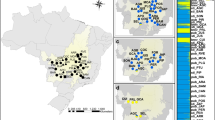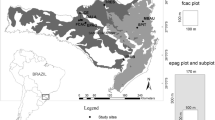Abstract
Trees of the Magnoliaceae family are of scientific, cultural and socio-economic importance. Kmeria septentrionalis Dandy (Magnoliaceae) is a dioecious tree, found in small, isolated, relic populations in Southern China, and is subject to extensive protection due to its rarity and high economic values. To improve conservation outcomes and in particular, germplasm collection guidelines, information on spatial genetic structure of the species is required. In this study, we investigated the spatial genetic structure and genetic diversity of 161 individuals of K. septentrionalis collected from five natural populations using AFLP molecular markers. Within-population genetic variation was measured, with percentage of polymorphic bands (PPB) ranged from 63% to 87%, while H S (genetic diversity within population) varied from 0.185 to 0.244 with a mean of 0.215 ± 0.025. Significant genetic differentiations were revealed between pairwise populations, indicating each population existing as an independent evolutionarily significant unit. Mantel test results showed no pattern of isolation-by-distance among populations separated by large distance. Fine scale spatial patterns of genetic variation suggested significant effects of isolation-by-distance within population at distances of 22 m. The results of contrasting genetic structure at coarse and fine scale in K. septentrionalis may indicate restricted pollen flow and seed dispersal at fine scales, and separated evolution in isolated populations over long period of time at coarser scales. Finally, we make several suggestions for improved management practices that may assist in the conservation of this species.



Similar content being viewed by others
References
An Z, Wang S, Wu X, Chen M, Sun D, Liu X, Wang F, Li Sun Y, Zhou W, Zhou J, Liu X, Lu H, Zhang Y, Dong G, Qiang X (1999) Eolian evidence from the Chinese Loess Plateau: the onset of the late Cenozoic Great Glaciation in Northern Hemisphere and the Qinghai-Xizang Plateau uplift forcing. Sci China Ser D 42:258–271
Callaway DJ (1994) The world of magnolias. Timber Press, Oregon
Cicuzza D, Newton A, Oldfield S (2007) The red list of Magnoliaceae fauna and flora international. Cambridge, UK
Corlett RT (2004) Flower visitors and pollination in the oriental (Indomalayan) region. Biol Rev 79:497–532. doi:10.1017/S1464793103006341
Doyle JJ, Doyle JL (1987) Isolation of DNA from fresh plant tissue. Phytochem Bull 19:11–15
Escudero A, Iriondo JM, Torres ME (2003) Spatial analysis of genetic diversity as a tool for plant conservation. Biol Conserv 113:351–365. doi:10.1016/S0006-3207(03)00122-8
Frankham R, Ralls K (1998) Inbreeding leads to extinction. Nature 392:441–442
Gao LM, Möller M, Zhang XM, Hollingsworth ML, Liu J, Mill RR, Gibby M, Li DZ (2008) High variation and strong phylogeographic pattern among cpDNA haplotypes in Taxus wallichiana (Taxaceae) in China and north Vietnam. Mol Ecol 16:4684–4698. doi:10.1111/j.1365-294X.2007.03537.x
He T, Smouse PE (2002) Paternity analysis in Ophiopogon xylorrhizus Wang et Tai (Liliaceae s.l.): selfing assures reproductive success. J Evol Biol 15:487–494. doi:10.1046/j.1420-9101.2002.00393.x
He T, Rao GY, You RL (2000) Reproductive biology of Ophiopogon xylorrhizus (Liliaceae s.l.): an endangered endemic of Yunnan, Southwest China. Aust J Bot 48:101–107
Hwang SY, Lin TP, Ma CS (2003) Postglacial population growth of Cunninghamia konishii (Cupressaceae) inferred from phylogeographical and mismatch analysis of chloroplast DNA variation. Mol Ecol 12:2689–2695. doi:10.1046/j.1365-294X.2003.01935.x
Law YW (1984) A preliminary study on the taxonomy of the family Magnoliaceae. Acta Phytotaxon Sin 22:89–109
Mantel N (1967) The detection of disease clustering and a generalized regression approach. Cancer Res 27:209–220
Matsuda H, Serizawa S, Ueda K, Kato T, Yahara T (2003) Assessing the impact of the Japanese 2005 World Exposition Project on vascular plants’ risk of extinction. Chemosphere 53:325–336. doi:10.1016/S0045-6535(03)00013-4
McKay JK, Christian CE, Harrison S, Rice KJ (2005) How local is local? A review of practical and conceptual issues in the genetics of restoration. Rest Ecol 13:432–440. doi:10.1111/j.1526-100X.2005.00058.x
Nagamitsu T, Ichikawa SE, Ozawa M, Shimamura R, Kachi N, Tsumura Y, Muhammad N (2001) Microsatellite analysis of the breeding system and seed dispersal in Shorea leprosula (Dipterocarpaceae). Int J Plant Sci 162:155–159. doi:10.1086/317902
Nei M (1978) Estimation of average heterozygosity and genetic distance from a small number of individuals. Genetics 89:583–590
Nie Z, Wen J, Azuma H, Qiu Y, Sun H, Meng Y, Sun W, Zimmer EA (2008) Phylogenetic and biogeographic complexity of Magnoliaceae in the Northern Hemisphere inferred from three nuclear data sets. Mol Phylogenet Evol 48:1027–1040. doi:10.1016/j.ympev.2008.06.004
Nybom H (2004) Comparison of different nuclear DNA markers for estimating intraspecific genetic diversity in plants. Mol Ecol 13:1143–1155. doi:10.1111/j.1365-294X.2004.02141.x
Pan CY (2007) Reproductive ecology research on rare and endangered species Kmeria septentrionalis Dandy. Master Degree Thesis, Guangxi University, China
Peakall R, Smouse PE (2006) Genalex 6: genetic analysis in Excel. Population genetic software for teaching and research. Mol Biol Notes 6:288–295. doi:10.1111/j.1471-8286.2005.01155.x
Rousset F (1997) Genetic differentiation and estimation of gene flow from F-statistics under isolation by distance. Genetics 145:1219–1228
Setsuko S, Ishida K, Tomaru N (2004) Size distribution and genetic structure in relation to clonal growth within a population of Magnolia tomentosa Thunb. (Magnoliaceae). Mol Ecol 13:2645–2653
Smouse PE, Peakall R (1999) Spatial autocorrelation analysis of individual multiallele and multilocus genetic structure. Heredity 82:561–573. doi:10.1038/sj.hdy.6885180
Tapponnier P, Lacassin R, Leloup PH, Schärer U, Zhong D, Wu H, Liu X, Ji S, Zhang L, Zhong J (1990) The Ailao Shan–Red River metamorphic belt tertiary left-lateral shear between Indochina and South China. Nature 343:431–437. doi:10.1038/343431a0
Vekemans X, Beauwens T, Lemaire M, Roldán-Ruiz I (2002) Data from amplified fragment length polymorphism (AFLP) markers show indication of size homoplasy and of a relationship between degree of homoplasy and fragment size. Mol Ecol 11:139–151. doi:10.1046/j.0962-1083.2001.01415.x
Vos P, Hogers R, Bleeker M, Reijans M, Van de Lee T, Hornes M, Frijters A, Pot J, Wheeler T, Peleman J, Kuiper M, Zabeau M (1995) AFLP: a new technique for DNA fingerprinting. Nucleic Acids Res 23:4407–4414. doi:10.1093/nar/23.21.4407
Zeng QW, Zhang DX, Gao ZZ, Xing FW (2003) Facultative apomixis in an endangered dioecious species, Woonyoungia septentrionalis (Magnoliaceae). Acta Bot Sin 45:1270–1273
Zhivotovsky L (1999) Estimating population structure in diploids with multilocus dominant DNA markers. Mol Ecol 8:907–913. doi:10.1046/j.1365-294x.1999.00620.x
Zhou SL, Peter Q (2003) Matrix generator (MG): a program for creating 0/1 matrix from sized DNA fragments. J Integr Plant Biol 45:766–767
Acknowledgments
The authors thank Shi-Liang Zhou, Shu-Hua Shi and Ren-Chao Zhou for assistance in laboratory and data analyses, and Paul Nevill and Ben Miller for assistance with English. We extend our thanks to two referees for their constructive comments on the earlier version of the manuscript. This study was supported by the Natural Science Foundation of Yunnan (Grant No. 2002C0018Q) and the Funds of the Chinese Academy of Sciences for Key Topics in Innovation Engineering (Grant No. KSCX2-YW-Z-002).
Author information
Authors and Affiliations
Corresponding author
Rights and permissions
About this article
Cite this article
Zhao, JL., He, T. & Li, QM. Contrasting coarse and fine scale genetic structure among isolated relic populations of Kmeria septentrionalis . Genetica 138, 939–944 (2010). https://doi.org/10.1007/s10709-010-9475-7
Received:
Accepted:
Published:
Issue Date:
DOI: https://doi.org/10.1007/s10709-010-9475-7




